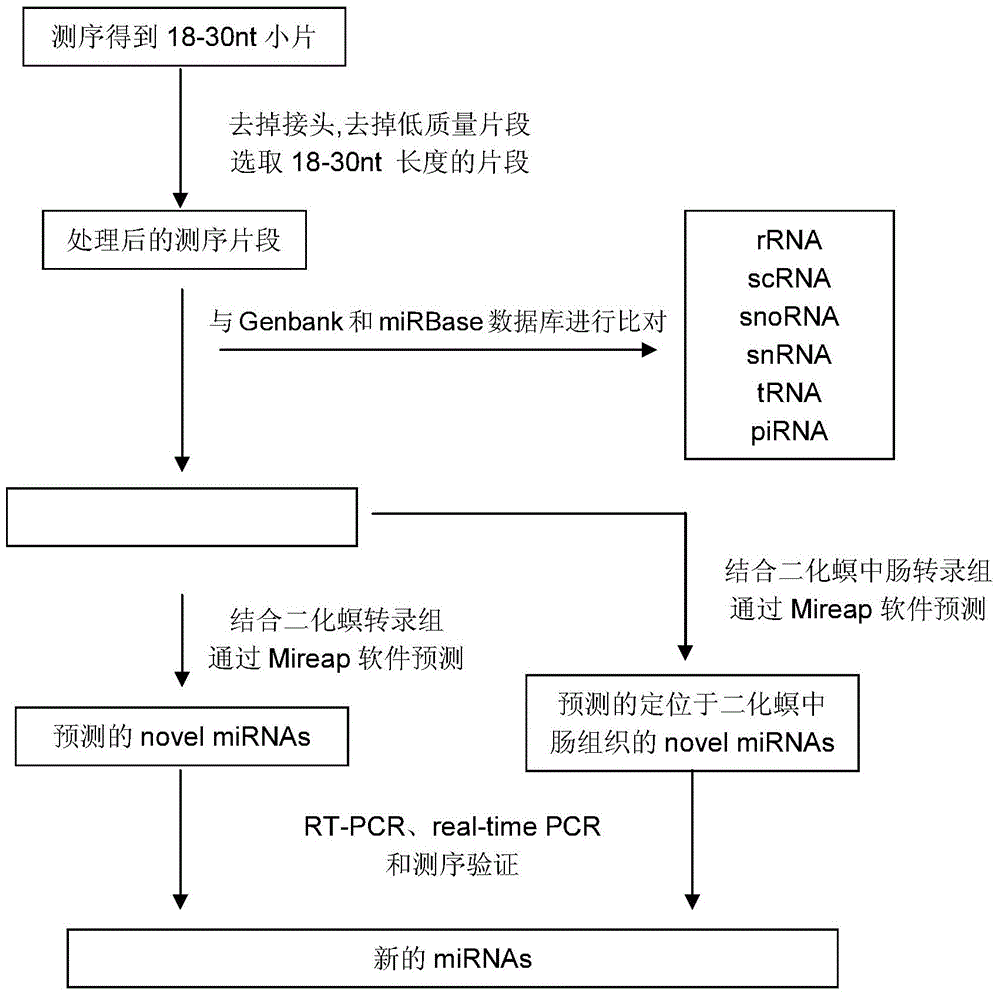Application of Chilo suppressalis endogenesis small RNA in rice inset resistance improvement
A rice and gene technology, applied in the direction of DNA / RNA fragments, applications, plant genetic improvement, etc., to achieve the effect of easy prediction, small fragments, and low risk
- Summary
- Abstract
- Description
- Claims
- Application Information
AI Technical Summary
Problems solved by technology
Method used
Image
Examples
Embodiment 1
[0049] Embodiment 1: the extraction of the small RNA sample of Chilo suppressalis
[0050] The life cycle of Chilo suppressalis includes four stages of growth and development: egg, larva, pupa and adult. The larval stage is usually divided into 5 instars. The present invention collects samples of six growth and development stages of the stem borer, including eggs, 1-2 instar larvae, 3-4 instar larvae, 5th instar larvae, pupae and adults. After collecting the samples of Chilo borer in various stages, put them into the liquid nitrogen tank and store them first. After all the samples are collected, use Trizol reagent for extraction. The method is as follows:
[0051] 1) Weigh 0.1 g of Chilo stem borer sample and grind it into powder in liquid nitrogen.
[0052] 2) Add 5ml Trizol reagent to quickly mix the ground sample powder, and distribute it in five 1.5ml RNAase-free centrifuge tubes.
[0053] 3) Leave it at room temperature for a few minutes until the mixture completely me...
Embodiment 2
[0065] Embodiment 2: the recovery and Solexa sequencing of the small RNA sample of Chilo suppressalis
[0066] The small RNA fragments below 80 nt were recovered by gel electrophoresis from the RNA samples of the 6 stages of Chilo suppressalis, and then the recovered small RNA fragments were connected with specific 3' end adapters and 5' end adapters. The 3' end primers were used for reverse transcription, and the obtained products were amplified by PCR with 5' and 3' end primers for high-throughput small RNA sequencing.
[0067] Sequencing by Solexa, each sample obtained 1 × 10 8 The amount of small fragments of data on the left and right, after obtaining these data, the analysis process is as follows figure 1 Place. First, the 5' and 3' end adapters were removed from the obtained fragment sequences, and the low-quality sequences were removed to select fragments with a length of 18-30nt. The processed fragments were compared with the Genbank database, and the conserved rRN...
Embodiment 3
[0071] Embodiment 3: verification of small RNA cus-15 expression
[0072] The new miRNA csu-15 of C. borer predicted by high-throughput sequencing and bioinformatics needs to be verified by experiments such as stem-loop RT-PCR (Chen et al.2005) and re-sequencing of RT-PCT products its truthfulness and accuracy. Its method is as follows.
[0073] According to the predicted candidate miRNA results, specific reverse transcription primers and PCR primers were designed, and the primers involved are shown in Table 1.
[0074] Table 1 Primer sequences required for stem-loop RT-PCR
[0075]
[0076] Firstly, DNase I was used to remove the genomic DNA in the samples, and then the 6 samples of C. borer were reverse-transcribed with the specific reverse transcription primer 15-specific-R. The system was as follows:
[0077] RNA sample: 1.0 μg
[0078] DNase I: 0.5 μl
[0079] 10×DNase I buffer1.0μl
[0080] Supplement DEPC-treated ddH 2 0 to 10 μl
[0081] React at 37°C for 15 m...
PUM
 Login to View More
Login to View More Abstract
Description
Claims
Application Information
 Login to View More
Login to View More - Generate Ideas
- Intellectual Property
- Life Sciences
- Materials
- Tech Scout
- Unparalleled Data Quality
- Higher Quality Content
- 60% Fewer Hallucinations
Browse by: Latest US Patents, China's latest patents, Technical Efficacy Thesaurus, Application Domain, Technology Topic, Popular Technical Reports.
© 2025 PatSnap. All rights reserved.Legal|Privacy policy|Modern Slavery Act Transparency Statement|Sitemap|About US| Contact US: help@patsnap.com



